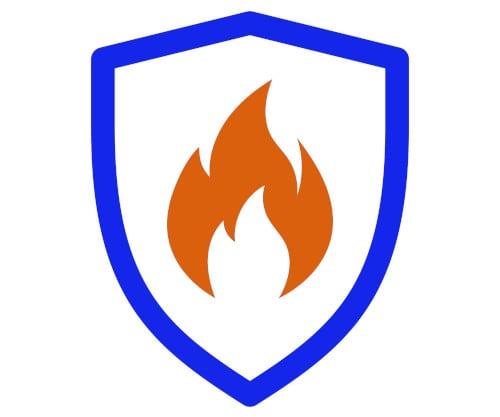Defining these inextricably intertwined but distinct concepts and systems
What is fire protection? What is life safety, exactly? And where do terms like fire prevention and fire safety enter the mix?
Many documents, blogs, and industry pros may seem to use the terms interchangeably. However, these closely related public safety concepts have fundamental differences, and some approaches to fulfilling their goals evolve.
Here’s a framework for understanding fire protection and life safety based on history, authoritative definitions, and common sense.

What is fire protection?
The dictionary is always a good place to start. Merriam-Webster defines fire protection as the “measures and practices for preventing or reducing injury and loss of life or property by fire.” However, Wikipedia, despite its perceived flaws, has a more specific definition (emphasis added):
Fire protection is the study and practice of mitigating the unwanted effects of potentially destructive fires. It involves the study of the behavior, compartmentalization, suppression and investigation of fire and its related emergencies, as well as the research and development, production, testing and application of mitigating systems.
“Mitigating” underscores what most fire protection equipment and rules do—reduce the impact of fires and, in some cases, even put them out.
For example, active fire protection systems actively do something in response to a fire, whether a fire alarm tells people to get out of the building or fire sprinklers spring into action to control or suppress it. Passive fire protection measures, such as fire-rated walls or fire dampers, inhibit the spread of a blaze and its effects. Those systems buy time and space for people to escape unharmed, and firefighters and active fire protection systems do their job.
Fire protection’s role in handling fires if they happen contrasts with the term “fire prevention” (part of a bigger category of “fire safety”), which aims to avoid destructive blazes in the first place.

What is life safety?
Merriam-Webster comes up empty here. So, a great place to seek clarity is NFPA 101: Life Safety Code. NFPA 101’s enhanced content provides a history lesson on the evolution of the code’s title (emphasis added):
The title of the Code was changed from Building Exits Code to Code for Safety to Life from Fire in Buildings and Structures in 1966. The change […] expanded the scope […] from a specification-based code for stairs, doors, and fire escapes to a performance- and specification-based code that addresses the myriad factors that affect life safety in the event of fire.
From 1966 through 2002, the Code was referred to by its shortened name, Life Safety Code. In 2003, the Code was officially renamed Life Safety Code.
The change in title reflects the Code’s ever-changing content. In some cases, the Code addresses non-fire, day-to-day building occupant use issues. For example, in 12.2.5.6.3 and 13.2.5.6.3, which apply to assembly occupancies, access and egress routes are required to be maintained so that crowd management, security, and emergency medical personnel are able to reach any individual at any time without undue hindrance.
Thus, “life safety” is simultaneously broader and more specific than “fire protection.”
It’s broader because the concept covers systems and measures that handle more than fires. For example, an alarm signal and wide egress paths and exits could be as valuable for escaping a riot or a benzene leak as during a fire. Glow-in-the-dark emergency signs have value during a power outage, a fire, or both.
The life safety concept is also more specific than fire protection in that its measures focus on preserving lives. Fire protection also aims to safeguard property, though the equipment may prioritize this goal a little differently based on a property’s hazard level.
For example, quick response sprinklers are designed to go off fast to control a fire, prioritizing buying time for people to escape a structure. In contrast, the design objective of early suppression fast response (ESFR) sprinklers is to suppress a fire, with property protection also a significant goal. Regardless, all sprinkler types (and other fire protection equipment) generally protect lives and property.

Here’s how the International Code Council defines fire protection and life safety in its International Building Code (IBC) and International Fire Code (IFC):
Fire Protection Systems. Approved devices, equipment and systems or combinations of systems used to detect a fire, activate an alarm, extinguish or control a fire, control or manage smoke and products of a fire or any combination thereof.
Life Safety Systems. Devices and equipment that enhance or facilitate evacuation, smoke control, compartmentation and isolation.
ICC’s definition of life safety still places much emphasis on fire. However, the explanatory text in these codes gets more comprehensive (emphasis added):
Life safety systems are installed in a building for the protection of human life during an emergency or failure of a critical building system. These systems include architectural designs that provide egress and protected areas within buildings by layout and construction type as well as mechanical and electric systems that perform a specific function. Some examples of life safety systems are fire alarm and detection systems, emergency alarm systems, smoke control systems, mass notification systems, and emergency and exit lighting.
One last definition: Encyclopedia Britannica’s meaning very quickly spells out some of the unique aspects of life safety:
Life-safety system, Any interior building element designed to protect and evacuate the building population in emergencies, including fires and earthquakes, and less critical events, such as power failures.

Fire protection, life safety, and their approaches expand with technology, codes, and standards
Given the threat fires pose in structures, it’s natural for many documents and definitions to center around fire protection measures. However, life safety systems include many items serving additional purposes, and this category is evolving.
Classic examples include emergency alarms, exit lighting, and architectural features that allow people to quickly evacuate a building. However, consider the evolving risks and measures used to protect people.
For example, are secured vestibules or access controls that could isolate an active shooter considered life safety systems or security systems? They’re arguably both, though some fire protection and life safety elements and proposed security measures can conflict with each other.
What about current and future “smart building” features that sense risks to lives and automatically react to them? Algorithms can already work with cameras to spot accidents and prone individuals who may have suffered a medical event, not to mention providing an alternate way of detecting fires.
Smart building systems can also take immediate action, like locking down or opening doors, closing fire shutters, ventilating smoke or toxic fumes, sounding alarms, or calling emergency services.
This evolution of risks and tech explains why NFPA:
- Introduced its concept of an integrated “Fire & Life Safety Ecosystem™” in 2018.
- Publishes NFPA 4: Standard for Integrated Fire Protection and Life Safety System Testing and includes related rules in other documents.
- Publishes some standards that have little to do with fires and everything to do with life safety, such as NFPA 3000: Standard for an Active Shooter/Hostile Event Response (ASHER) Program and NFPA 102: Standard for Grandstands, Folding and Telescopic Seating, Tents, and Membrane Structures.
Life safety systems will continue evolving, along with their crucial, close relationship with fire protection. And these concepts and definitions will expand along with them.
If you need fire protection (and some life safety) equipment, check out QRFS’s online selection. If you have any questions, contact us at support@qrfs.com or 888-361-6662.
This blog was originally posted at blog.qrfs.com. If this article helped you, check us out at Facebook.com/QuickResponseFireSupply or on X @QuickResponseFS.


